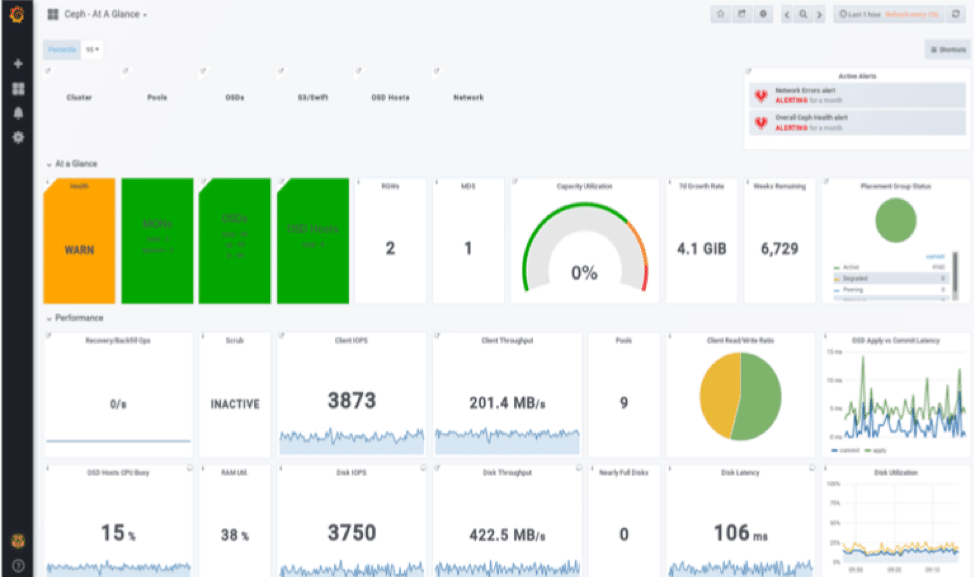IBM Storage Ceph, formerly Red Hat Ceph, has been on a mission to simplify the deployment and management of its software-defined storage (SDS) platform.
What once was hard has become easy. Since IBM announced the integration of Red Hat storage products into IBM Storage, there has been a surge in interest and growth as customers adopt cloud-native architectures. Those customers are realizing the public cloud’s cost, speed, and elasticity benefits. As such, IBM Storage Ceph, formerly Red Hat Ceph, has been on a mission to simplify the deployment and management of its software-defined storage (SDS) platform. The flexibility and scalability also make IBM Storage Ceph the ideal solution for handling generative AI use cases.
IBM Storage Ceph provides an open, scalable, and software-defined multi–protocol storage solution designed to consolidate data anywhere and everywhere. Optimized for large single and multisite deployments, IBM Storage Ceph efficiently scales to support hundreds of petabytes of data and, in published tests, can support tens of billions of objects. This type of scale and inherent resiliency and security are key for supporting data lakehouses and AI/ML open-source frameworks.
Self-healing, Self-managing Platform
The flexibility of IBM Storage Ceph is apparent in management simplicity and enhanced agility in adjusting to growing business needs while scaling compute and capacity as new workloads are introduced. The self-healing, self-managing elements of the platform are designed to deliver unified file, block, and object storage services running on industry-standard hardware. The unified storage provides clients a bridge from legacy applications running on independent file or block storage to a common platform with object storage in a single appliance.
Support for data lakehouse and AI/ML, along with traditional workloads like MySQL and MongoDB on Red Hat OpenShift or Red Hat OpenStack, is a primary reason 768 TiB raw capacity of IBM Storage Ceph is included with watsonx.data, IBM’s open, governed, fit-for-purpose data lakehouse architecture.
A Solution To Address Continued Data Growth
The explosive growth of unstructured data and generative AI, a trend unlikely to abate anytime soon, influence and benefit each other. Gartner’s Top Trends in Enterprise Data Storage 2023 report suggests that “by 2028, large enterprises will triple their unstructured data capacity across their on-premises, edge, and public cloud locations compared to mid-2023.”
The growth of unstructured data like text, images, and videos fuels generative AI, helping it make sense of this data and find valuable insights. This creates a loop: AI improves with more data, and its realistic data generation enhances our understanding of unstructured datasets, leading to more innovation.
The same Gartner report predicts that “by 2028, 70 percent of file and object data will be deployed on consolidated unstructured data storage platform(s), up from 35 percent in early 2023.” As such, organizations will require a storage management solution that speeds up data handling – from ingestion and cleaning to classification and metadata management – and offers cloud-scale capacity management and deployment, all of which are available in a software-defined storage solution. The scale-out qualities of IBM Storage Ceph can seamlessly meet these growing data demands.
To accelerate and scale the impact of data and AI across an organization, IBM believes that companies need to implement a hybrid design. This will ultimately improve business outcomes. IBM Storage Ceph offers on-prem storage with a cloud-like model, addressing problems like the absence of enterprise features in public clouds, data sovereignty, and costs. Its easy-to-integrate architecture works with various platforms, clouds, hypervisors, open-source databases like Apache Iceberg and Parquet, and full stacks like watsonx.ai, watsonx.data. You can add new nodes or devices easily without interrupting service. It is an excellent choice for constructing a data lakehouse using watsonx.data and other AI workloads.
IBM Storage Ceph 7.0 Prepares for NVMe/TCP
IBM has been busy during 2023, introducing essential updates to Ceph, including IBM Storage Ceph 7.0. This next-generation Ceph platform prepares for NVMe/TCP capabilities designed to deliver faster data transfer between storage devices, servers, and cloud platforms while maintaining the low-latency and high-bandwidth characteristics of traditional NVMe.
IBM Storage Ceph is perfect for applications requiring high-speed storage, like databases, analytics, and content delivery. The architecture makes it easy to fit into current network environments, helping customers easily shift to a software-defined model for faster, more agile, and cost-effective operations.
NVMe/TCP lets Ceph enhance traditional block storage with scalable designs. With NVMe/TCP, Ceph can work with platforms like VMware, allowing businesses to mimic cloud setups in their data centers. This move can reduce reliance on costly, inflexible SAN networks and large storage arrays.
Other features in Ceph 7.0 include:
- SEC and FINRA compliance certification for WORM with object lock, enabling WORM compliance for object storage
- NFS support for CephFS filesystem access for non-native Ceph clients
For more details on features, visit the IBM Storage community.
No More Hardware Restrictions
IBM Storage Ceph stores data as objects within logical storage pools, allowing a single cluster to have multiple pools, each tuned to different performance or capacity requirements. Customers benefit from easier and faster data access with content and context classifications, storage capacity limited only by the size of the infrastructure, and cost reductions at scale by removing hardware restrictions compared to traditional and legacy storage array architectures.
Ceph deployment has been made easier with IBM Storage Ready Nodes. This means the platform can be deployed as a complete software and hardware solution. Ready Nodes are available in various capacity configurations optimized for IBM Storage Ceph workloads.
Real World Adventure
Ceph.io takes you through some troubleshooting techniques when migrating from HDD to NVMe. Clyso was approached by a fairly hip and cutting-edge company that wanted to transition its HDD-backed Ceph cluster to a 10-petabyte NVMe deployment. Check out all the details from Ceph.io.
Engage with StorageReview
Newsletter | YouTube | Podcast iTunes/Spotify | Instagram | Twitter | TikTok | RSS Feed


